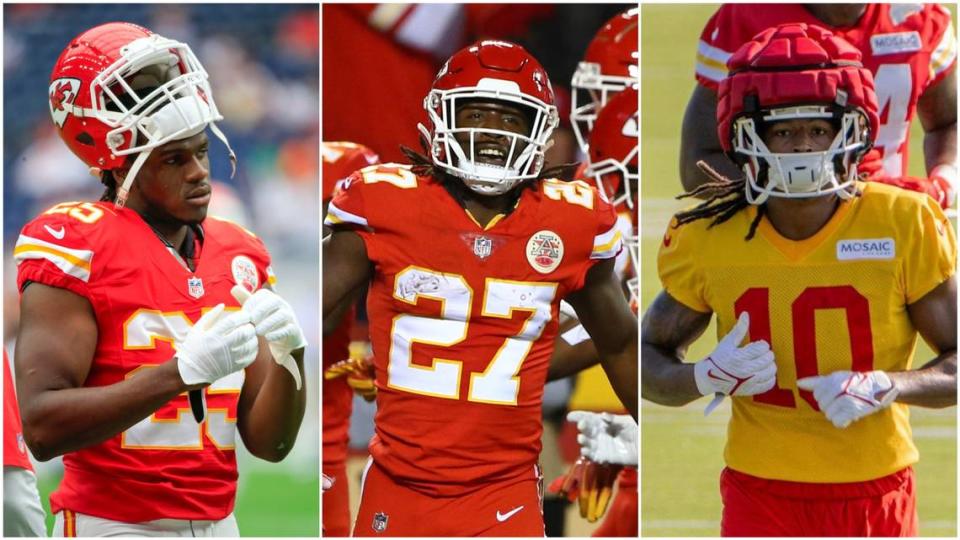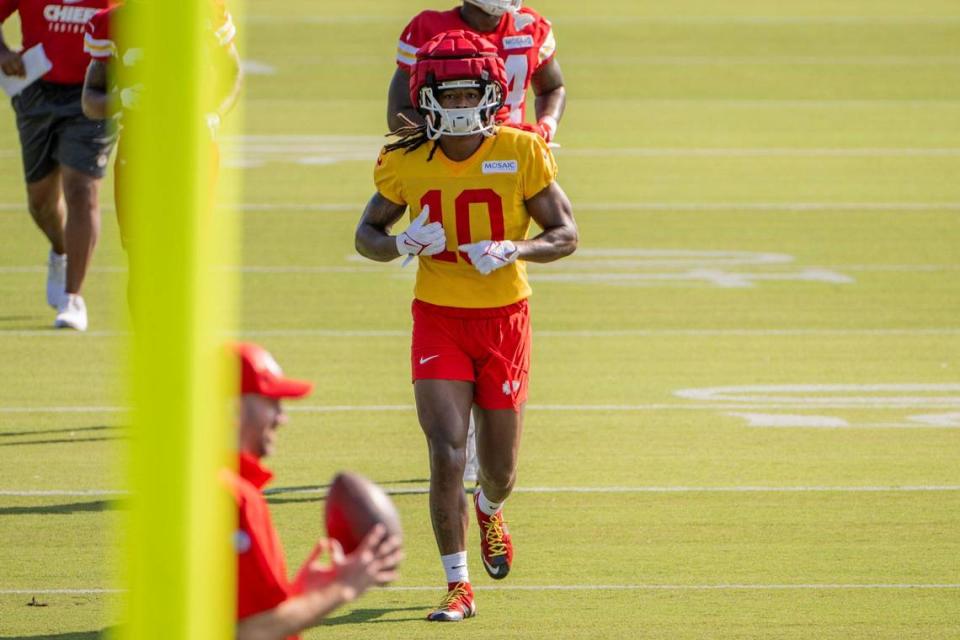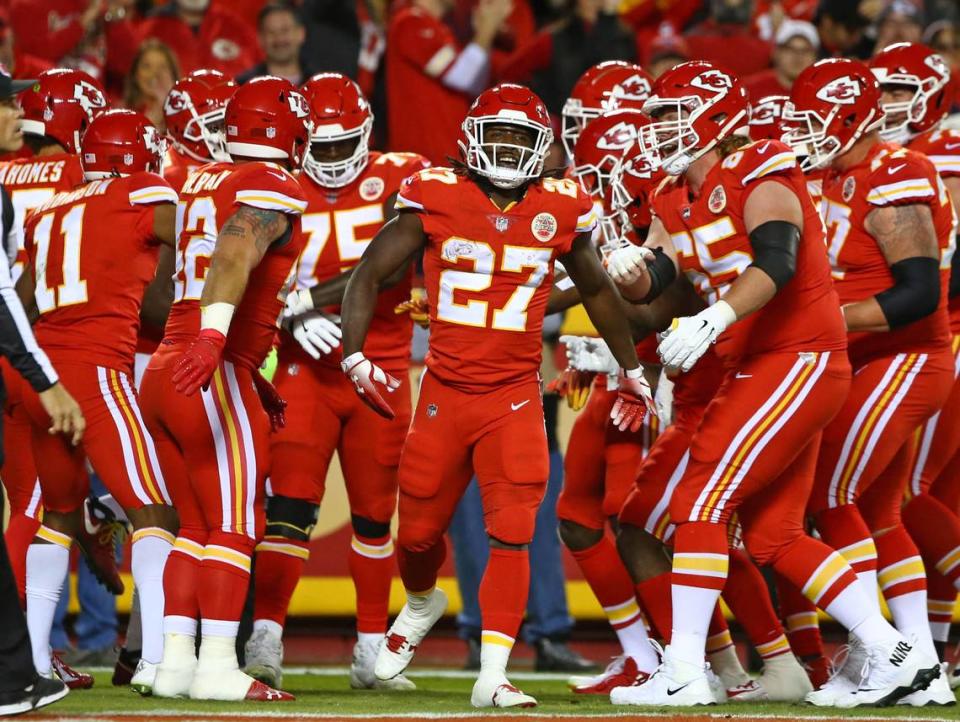Are NFL running backs underpaid? Here’s how much Kansas City Chiefs have paid their RB1
Running back contracts were a hot topic on social media earlier this week, as the deadline for NFL teams to sign designated “franchise players” to contract extensions passed on Monday.
A Kansas City Chiefs rusher was prominently referenced in the greater social media conversation about running backs, and overall, the discourse compelled some digging on the Chiefs’ history of running back compensation.
The aforementioned social media discussions centered on the New York Giants’ Saquon Barkley, Las Vegas Raiders’ Josh Jacobs and Dallas Cowboys’ Tony Pollard as tagged rushers who did not reach new agreements with their teams. With their one-year tenders, the running backs are owed $10,091,000 this season and will be unrestricted free agents in 2024.
Pollard signed his tender given it was a more-than-tenfold increase from the $965,000 the former fourth-round pick made last season. Jacobs and Barkley, however, were likely hoping for compensation that they feel better reflects their production after they finished first and fourth, respectively, among league rushing leaders last season.
They have not signed their tenders and could resort to sitting out training camp and even the 2023 season to guard against injury and protect their long term financial interests. Former Chief Le’Veon Bell did exactly that while tagged by the Pittsburgh Steelers in 2018.
Running backs are seemingly being devalued even as the NFL and teams’ pockets deepen. The three other players who received the non-exclusive franchise tag this offseason — quarterback Lamar Jackson, tight end Evan Engram and defensive tackle Daron Payne — all got hefty new contracts, but no such love for running backs.
Other top backs like Derrick Henry, Jonathan Taylor and Christian McCaffrey voiced their dismay at the situation over social media. In 2019, efforts were made to separate running backs from the NFL Players Association and into their own union via a petition filed with the National Labor Relations Board. Perhaps those efforts will be renewed after this latest round of contract negotiations.
Regarding the Chiefs, Kansas City sports media personality Carrington Harrison offered this take about second-year back Isiah Pacheco, who posted 960 yards from scrimmage and five touchdowns last season:
“A player like Isiah Pacheco is really screwed by the system,” Harrison wrote on Twitter. “He’s 24 and a seventh round pick. He has to play two more seasons under his rookie deal, can’t hold out for the final season and the Chiefs can tag him. He could possibly not hit (free agency) until he’s 28-29. He’s never getting paid.”
Others on social media argued Pacheco’s ascendance to lead ball carrier for a Super Bowl-winning team, despite being a lightly-paid seventh round pick, tanked the market for other running backs by further showing teams they don’t need to invest significantly to find utility.
All of it provoked this thought: How have the Chiefs historically paid their top rushers?
The Chiefs have had some special running backs in their history, even in the more recent days that began when the tide changed from Priest Holmes and Larry Johnson to Jamaal Charles. Going as far back in Chiefs backfield history as OverTheCap.com’s year-to-year salary data is available, I charted the salary cap number for each of the team’s top rushers since 2009, from Charles to Kareem Hunt to Pacheco.
Here’s what we learned...
How much the Kansas City Chiefs have paid their top RB each year
The Chiefs have an interesting history at the running back position — where bigger numbers haven’t always led to more team success.
Charles, for example, produced regardless of his salary — and regardless of how the team did. The Chiefs got a 1,000-yard rushing season out of him when he cost them as little as $585,000 (they went 4-12) and as much as $9,633,333 (9-7 season).
Even with his success, the team ranged from 2-14 to 11-5 with him leading the offense. They averaged as few as 13.2 points per game and as many as 26.9.
All salary cap numbers from the following table are via OverTheCap.com:
Year | Name | Salary cap number | Yards from scrimmage | Total TDs | Chiefs PPG | Record |
2009 | Jamaal Charles | $585,000 | 1,417 | 8 | 18.4 | 4-12 |
2010 | Jamaal Charles | $2,003,333 | 1,935 | 8 | 22.9 | 10-6 |
2011 | Jackie Battle | Not available | 665 | 2 | 13.3 | 7-9 |
2012 | Jamaal Charles | $4,833,333 | 1,745 | 6 | 13.2 | 2-14 |
2013 | Jamaal Charles | $4,333,333 | 1,980 | 19 | 26.9 | 11-5 |
2014 | Jamaal Charles | $9,633,333 | 1,324 | 14 | 22.1 | 9-7 |
2015 | Charcandrick West | $510,000 | 848 | 5 | 25.3 | 11-5 |
2016 | Spencer Ware | $958,333 | 1,368 | 5 | 24.3 | 12-4 |
2017 | Kareem Hunt | $658,988 | 1,782 | 11 | 25.9 | 10-6 |
2018 | Kareem Hunt | Cut ($642.9K cap charge) | 1,202 | 14 | 35.3 | 12-4 |
2019 | Damien Williams | $1,733,333 | 711 | 7 | 28.2 | 12-4 |
2020 | Clyde Edwards-Helaire | $1,967,559 | 1,100 | 5 | 29.6 | 14-2 |
2021 | Darrel Williams | $1,594,118 | 1,010 | 8 | 28.2 | 12-5 |
2022 | Isiah Pacheco | $724,777 | 960 | 5 | 29.2 | 14-3 |
Later, the Chiefs signed Damien Williams in 2018 to be their backup. He was re-signed and took the lead role in 2019 after Hunt was released in light of an off-field issue.
Though Damien Williams helped Kansas City to a Super Bowl win in 2019, they arguably got better production from Charcandrick West in 2015 and Hunt in 2017 on rookie contracts that were well less than half of Williams’ cap hit.
Another takeaway: With Patrick Mahomes and Andy Reid leading the offense, the Chiefs haven’t needed a big-name or big-salary running back to find team success.
Last season, Pacheco didn’t top 1,000 yards like Clyde Edwards-Helaire and Darrel Williams the two years before him, but he got close enough. He had the same number of touchdowns as Edwards-Helaire in 2020 and the Chiefs averaged an additional point per game and won two more games in 2022 than in 2021 with Darrel Williams as their main running back.
Pacheco, at $724,777 against the cap, cost just over $1 million less than Damien Williams, $1.24 million less than Edwards-Helaire and $869 thousand less than Darrel Williams for similar — and against Damien Williams, better — production.
So at least in Kansas City, where the quarterback and coach are in place, there doesn’t seem to be much of a path to paying a running back a top-level salary.

 Yahoo Autos
Yahoo Autos 

